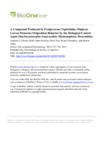Por favor, use este identificador para citar o enlazar este ítem:
http://www.alice.cnptia.embrapa.br/alice/handle/doc/909060| Título: | A Compound produced by fruigivorous Tephritidae (Diptera) larvae promotes oviposition behavior by the biological control agent Diachasmimorpha longicaudata (Hymenoptera: Braconidae). |
| Autor: | STUHL, C.  SIVINSKI, J.   TEAL, P.   PARANHOS, B. A. J.   ALUJA, M.   |
| Afiliación: | CHARLES STUHL, Department of Entomology and Nematology, University of Florida; JOHN SIVINSKI, Center for Medical, Agricultural and Veterinary Entomology, USDA; PETER TEAL, Center for Medical, Agricultural and Veterinary Entomology, USDA; BEATRIZ AGUIAR JORDAO PARANHOS, CPATSA; MARTIN ALUJA, Instituto de Ecologia, Xalapa, Veracruz, Mexico. |
| Año: | 2011 |
| Referencia: | Environmental Entomology, v. 40, n. 3, p. 727-736, 2011. |
| Descripción: | Tephritid fruit ßy parasitoids use fruit-derived chemical cues and the vibrations that result from larval movements to locate hosts sequestered inside fruit. However, compounds produced by the larvae themselves have not been previously described nor their signiÞcance to parasitoid foraging determined. We collected the volatiles from four species of tropical and subtropical Tephritidae: Anastrepha suspensa (Loew), Bactrocera dorsalis Hendel, Bactrocera cucurbitae Coquillett, and Ceratitis capitata (Wiedemann), representing two subfamilies (Dacinae and Trypetinae). Paraethylacetophenone, an analog of a known tephritid parasitoid attractant, was a major constituent of all four, and was not associated with larvae of another acalypterate ßy, Drosophila melanogaster Meigen, or with the calypterate Musca domestica L. It also was present in volatiles from whole, A. suspensa infested fruits of Eugenia uniflora (L.). Para-ethylacetophenone was not necessarily produced as a direct consequence of fruit consumption because it also was detected from larvae that developed in two artiÞcial diets and in spent diets subsequent to larval development. Sensillae on both the antennae and ovipositor of the opiine braconid fruit ßy parasitoid, Diachasmimorpha longicaudata (Ashmead) responded to the para-ethylacetophenone in larval volatiles and as a synthetic. Although a potential cue to foraging parasitoids, para-ethylacetophenone showed no long range (1m) at- tractiveness to the adult female parasitoid, but did stimulate ovipositor-insertion and oviposition into both a natural (fruit) and an artiÞcial (paraÞlm) substrate. Thus it may prove useful in colonizing and mass-rearing opine fruit ßy parasitoids. |
| Thesagro: | Anastrepha Bactrocera Mosca das Frutas |
| NAL Thesaurus: | Diachasmimorpha longicaudata Ceratitis |
| Palabras clave: | Para-ethylacetophenone |
| DOI: | 10.1603/EN10198 |
| Tipo de Material: | Artigo de periódico |
| Acceso: | openAccess |
| Aparece en las colecciones: | Artigo em periódico indexado (CPATSA)  |
Ficheros en este ítem:
| Fichero | Descripción | Tamaño | Formato | |
|---|---|---|---|---|
| Beatriz2011.pdf | 375.19 kB | Adobe PDF |  Visualizar/Abrir |









